|
ARBOR Gladius G0830 POS System
Flexible, innovative Intel Cherry Trail-powered fanless 8-inch tablet and dock system for point-of-sale, retail and warehousing deployments
(by Conrad H. Blickenstorfer)
In this article we're looking at the Gladius G0830 from ARBOR Technology, a Taiwan-based ISO-9001 certified embedded and networking manufacturer founded over two decades ago. The Gladius G0830, initially announced early 2016, nominally is a light and handy 8-inch tablet for various warehousing, retail, and mobile point-of-sale applications. In essence, however, it is really a system more than just a single device, a system that consists of the tablet, a docking station or desktop cradle, a special pistol grip, and even a thermal printer. The tablet can be used by itself, but ARBOR's primary intent here was to offer a comprehensive mPOS solution that customers can order à-la-carte.
The image below shows the Gladius G0830 inserted into its multi-purpose cradle on the left, and separate as a stand-alone tablet on the right.
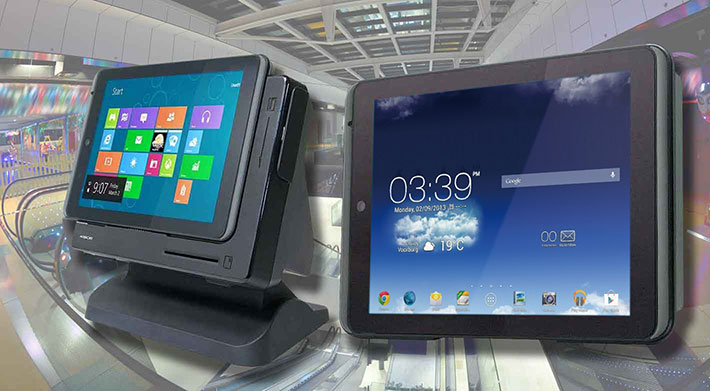
Right upfront, let's establish what ARBOR is, and what the Gladius tablet is. ARBOR has a broad product lineup that includes, in addition to rugged mobile computers, numerous embedded computing boards and modules, industrial PCs and touch panel computers, as well as healthcare computing equipment. ARBOR has been using the term "Gladius" for its rugged tablets and handhelds for years. The "gladius" was the standard-issue and primary armament of Roman legionnaires, a sword, and perhaps ARBOR chose the term as it considers their rugged mobile computing gear the primary tool and weapon of modern field forces.
Mobile Point-of-Sale requirements
To understand the Gladius G0830 requires a look at point-of-sale logistics. Point-of-Sale refers to the completion of a retail transaction. A buyer wishes to purchase a product or service at a retail location and then needs to pay for it. Supermarket checkouts are fixed point-of-sale stations that customers walk up to pay for their items. Mobile point-of-sale setups are different in that the traditional checkout counter is replaced with a mobile system that can be used virtually anywhere.
What does the mobile point-of-sale (mPOS) approach require? That would be a device that can record and process a sale. This involves several steps and may involve both manual and automatic processes. In fully electronic mobile systems, item IDs are scanned, credit and debit card information is read via magnetic stripe or chip, and the interaction between the mPOS system wirelessly communicates back and forth with the card processing entity.  The customer is authenticated via electronic means, a pin number, or both. If required, a signature can be captured via electronic ink. Once a transaction has cleared, a receipt may be emailed to the customer or printed on a mobile printer. The customer is authenticated via electronic means, a pin number, or both. If required, a signature can be captured via electronic ink. Once a transaction has cleared, a receipt may be emailed to the customer or printed on a mobile printer.
Most mPOS systems integrate some but not all of these assorted means of data collection into the actual mobile device that's being carried around. Why not have everything in one device?
Because having all conceivably required physical ports and all possible data capture and authentication technologies onboard would add too much size and weight to a mobile system. Hence ARBOR put part of the reading and authentication subsystems into the tablet, and part into the cradle.
But doesn't that approach defeat the very purpose of an mPOS system? It doesn't; the cradle is still small and light (3.6 pounds) to bring along almost anywhere.
And by not integrating all of the conceivably required mPOS components into the tablet, ARBOR broadened the appeal of the G0830 tablet beyond just mPOS applications. There are numerous warehousing, hospitality, and retail applications that need RFID/NFC, cameras, and scanners, but not necessarily the card readers and authentication modules.
Taking a look at the Gladius G0830
The first impression of the Gladius G0830 depends on whether one looks at just the tablet, or at the tablet inserted into its multi-function dock. Inserted into the dock, the assembly looks like a nicely designed and very compact POS system.
The tablet is, for being part of a professional POS setup, surprisingly small and elegant. Its 8.21 x 5.93 inch footprint is just barely larger than that of an iPad mini (7.8 x 5.3 inches). Yet, despite its small size, it's immediately clear that this is a device for work, tough and durable enough to take some abuse. That's evident in the rubberized protection that goes around the entire unit. And also in the raised rubberized bumper strips to the left and right of the display. Why is that important? Because roughly half of all smartphone and tablet users have experienced a shattered display, and displays shatter when they fall flat onto their glass surface. Even small bumpers radically reduce that possibility.
Below is a look at the Gladius G0830 tablet from the front and from all four sides. This shows that while from the front the device looks just like a consumer media tablet, the side views reveal that this is a tool for the job.

Note that despite the tablet's obvious toughness and the presence of protected ports and an industrial grade barcode reader, the body of the Gladius G0830 is only half an inch thick, with the scanner "bulge" protruding another fraction of an inch. Also note the front glass providing enough of a margin beyond the LCD screen for unimpeded operation of the capacitive touch display.
Looking at the side views, there's the surface-mount spring-loaded pin dock connector at the bottom, the scanner window on top with the volume rocker and the power button next to it. The tablet's I/O is split into two blocks, both of which have tight-fitting protective rubber covers. The covers provide a good friction seal as long as they are pushed into place properly. Unlike some such covers, these are easy to open and they can't get lost because they are attached to the unit with a short rubber strip.
The image below shows the left side of the Gladius tablet with the protective doors open (and photoshopped out of the way). The lefthand I/O block includes a standard audio jack and a slot for a Micro SIM card. The righthand block has a micro USB 2.0 port with OTG support, and next to it a micro SD card slot.

Looking at just the tablet alone, one might wonder why there isn't also a standard USB port or two, as there'd be room for it. But the tablet is part of a system, and so all the standard-size I/O (USB, RJ45, HDMI) is in the dock.
Design and construction
In terms of construction, the Gladius G0830 consists of a black polymer plastic back half and a very sturdy aluminum front, also black. The black plastic of the rear has a crosshatch pattern that almost makes the surface look like carbon fiber and provides some extra grip. The rear also has dark-gray rubberized protective molding that goes around the entire device. 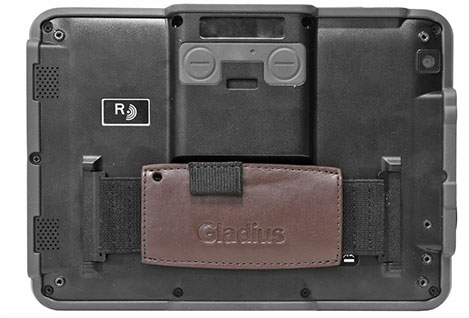
At first sight it looks like the entire front face is glass, but the glass is actually inlaid into the aluminum front, and there is a quarter-inch bezel on the short sides of the rectangle that also has dark-gray rubber molding on it for protection.
There are no access doors on the back of the device, and there's also no battery compartment door. There are two metal braces that act as anchors for an elastic handstrap. And there's a bulge that houses the unit's Zebra SE4710 1D/2D scanner.The gray inlay in the scanner bulge is actually two scanner buttons.
Also note the unit's camera lens cover in the upper right. There does not appear to be an LED flash. On the other side of the device are two small grilles for the stereo speakers.
To open the tablet and get a peek inside (or get to the battery) is easy. Just undo ten small black Philips screws and the two halves can easily be separated. There are no pesky clips or snaps here. There is just a single wire assembly going between the two halves. It connects the scanner to the motherboard and can easily be disconnected.
The seal between the two halves is a tongue-and-groove design where a plastic lip on the back half presses into a groove around the aluminum front. There's no o-ring seal. We're not totally thrilled with this solution, but it's good enough for IP54 sealing. More evidence of the IP54 sealing are the two speaker grilles that keep water out with just a pressure seal around the two little speakers on the front side, and the screw holes that are inside the unit, without additional protective rubber washers. Again, that's all fine for IP54.
Now you can examine the inside of the Gladius G0830. The backside is really just a bare cover with nothing but the scanner mounted on it. All electronics and components are mounted onto the front half.
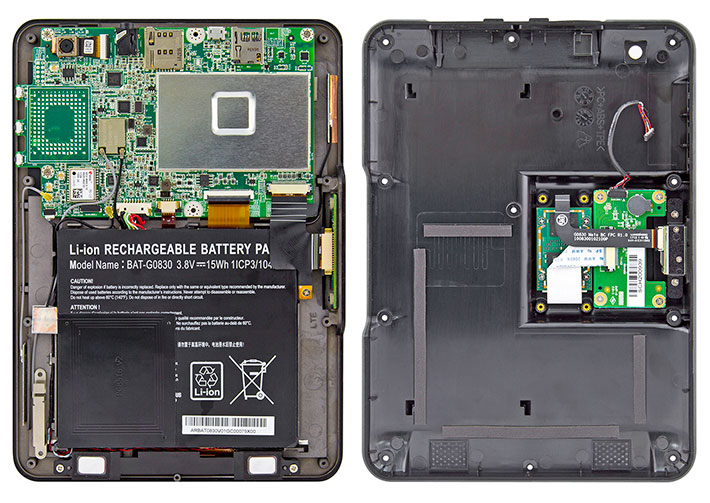
Prominently visible now is the large, but very thin, Lithium-Polymer battery. It's a 3.8 Volt, 4,000 mAh design that makes for 15.2 watt-hours. The battery sits loose in between two metal guides that are part of the overall aluminum front of the tablet. While not externally accessible, replacing the battery, which is plugged into the mother board, is therefore easy. The black rectangle on top of the battery is the NFC antenna.
The unit's motherboard measures roughly 5 x 3.25 inches. It is not as hyper-integrated as your typical smartphone or consumer tablet circuit boards, but it's considerably more miniaturized as even small PC-style boards. No daughterboards, PCIe slots or other separate components here; everything is soldered right onto the motherboard. All of the G0830's I/O, controls and card slots are edge-mounted on the motherboard, too.
There are no RAM slots or visible mass storage either. That's all integrated into the motherboard. That saves space, but also means that whatever comes with the device is what you get, in this case 2GB of DDR3L RAM and 64GB of eMMC mass storage. The latter can be complemented via the externally accessible microSD card slot.
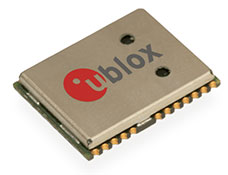 It almost goes without saying that the unit's super-efficient Atom x5-Z8350 processor doesn't require a fan. In fact, it doesn't need heat pipes or any other thermal engineering either. Whatever heat it produces is soaked up by the unit's substantial aluminum front and also a 2x3 inch of copper foil (which we removed for the photography). It almost goes without saying that the unit's super-efficient Atom x5-Z8350 processor doesn't require a fan. In fact, it doesn't need heat pipes or any other thermal engineering either. Whatever heat it produces is soaked up by the unit's substantial aluminum front and also a 2x3 inch of copper foil (which we removed for the photography).
The only separate and distinctly visible module on the main board is a u-blox NEO-M8N GNSS module for positioning. One cool thing about the M8 is that it can track up to three of the four available GNSS systems concurrently, those being GPS (the US system), GLONASS (the Russian version of GPS), the European Galileo, the Chinese BeiDou, and the Japanese XZSS. This multiplies the number of available satellites, which makes for quick starts, very good accuracy, and superior coverage.
Powered by Intel Cherry Trail
Tablet manufacturers today have their choice of a very wide range of processors, ranging, on the Intel side, from basic Atom chips all the way up to high-end Core processors with many times the features and performance (and costing up to 20 times as much). Aiming for an affordable price tag and fanless operation, but still respectable performance, ARBOR chose the Intel Atom X5-Z8350. This requires a bit of commentary.
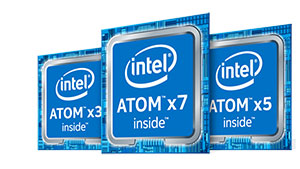 The 1.44GHz quad-core X5-Z8350 is part of Intel's next-gen 64-bit "Cherry Trail" system-on-chip platform that is based on contemporary 14nm process technology and comes with Broadwell-architecture Intel HD Graphics. The X5-Z8350 has a very low thermal design power of just 2 watts and can reach burst frequencies of up to 1.92GHz. Compared to the predecessor "Bay Trail" platform, comparable "Cherry Trail" chips aren't necessarily quicker, but their Broadwell-type graphics subsystems are said to be substantially faster. The 1.44GHz quad-core X5-Z8350 is part of Intel's next-gen 64-bit "Cherry Trail" system-on-chip platform that is based on contemporary 14nm process technology and comes with Broadwell-architecture Intel HD Graphics. The X5-Z8350 has a very low thermal design power of just 2 watts and can reach burst frequencies of up to 1.92GHz. Compared to the predecessor "Bay Trail" platform, comparable "Cherry Trail" chips aren't necessarily quicker, but their Broadwell-type graphics subsystems are said to be substantially faster.
What's also interesting is that "Cherry Trail" supports Windows as well as Android. As a result, ARBOR offers the G0830 either with Windows 10 or with Android 5.x.
To see how the quad-core X5-Z8350 fares in the Gladius G0830, we used Passmark Software's PerformanceTest 6.1 that runs about 30 tests covering CPU, 2D graphics, 3D graphics, memory, and disk and then computes scores for each category and an overall PassMark score. We also ran our secondary standard benchmark suit, CrystalMark. For comparison, we're listing our benchmark results for a variety of other industrial, enterprise and vertical market tablets RuggedPCReview has recently tested. The results are as follows:
|
ARBOR G0830 Benchmarks and Comparisons
|
|
PERFORMANCE COMPARISON
|
ARBOR
|
ARBOR
|
Advantech
|
MobileDemand
|
MobileDemand
|
Trimble
|
|
Model
|
Gladius G0830
|
Gladius G0975
|
MIT-M101
|
Flex 8
|
T8500
|
Kenai
|
|
Processor Type
|
Intel Atom
|
Intel Celeron
|
Intel Celeron
|
Intel Atom
|
Intel Atom
|
Intel Atom
|
|
Processor Type: Intel
|
X5-Z8350
|
N2930
|
N2930
|
Z3775
|
Z3735F
|
E3826
|
|
Code name
|
Cherry Trail
|
Bay Trail
|
Bay Trail
|
Bay Trail
|
Bay Trail
|
Bay Trail
|
|
Thermal or Scenario Design Power
|
2.0 watts (SDP)
|
7.5 watts (TDP)
|
7.5 watts (TDP)
|
2.0 watts (SDP)
|
2.0 watts (SDP)
|
7.0 watts (TDP)
|
|
CPU Clock
|
1.44/1.92GHz
|
1.83/2.16GHz
|
1.83/2.16GHz
|
1.33/1.83GHz
|
1.33/1.83GHz
|
1.46GHz
|
|
CPU Cores/Threads
|
4/4
|
4/4
|
4/4
|
4/4
|
4/4
|
2/2
|
|
Graphics
|
Intel HD
|
Intel HD
|
Intel HD
|
Intel HD
|
Intel HD
|
Intel HD
|
|
CPU Mark
|
1,639.7
|
2,202.7
|
1,555.2
|
1,589.5
|
1,115.1
|
499.8
|
|
2D Graphics Mark
|
96.7
|
160.2
|
177.6
|
178.2
|
112.7
|
86.4
|
|
Memory Mark
|
281.3
|
411.4
|
424.3
|
421.1
|
283.2
|
249.4
|
|
Disk Mark
|
618.5
|
1,257.0
|
2,121.3
|
288.0
|
902.7
|
1,726.5
|
|
3D Graphics Mark
|
141.4
|
141.6
|
142.0
|
147.4
|
99.2
|
122.0
|
|
Overall PassMark
|
647.6
|
959.6
|
962.4
|
605.2
|
560.3
|
550.1
|
|
ALU
|
21,436
|
28,174
|
28,563
|
29,126
|
20,734
|
9,897
|
|
FPU
|
17,627
|
24,954
|
24,142
|
24,532
|
17,523
|
8,058
|
|
MEM
|
18,176
|
22,166
|
21,371
|
25,540
|
19,712
|
15,386
|
|
HDD
|
19,628
|
27,245
|
32,575
|
10,649
|
24,812
|
35,416
|
|
GDI
|
3,473
|
5,319
|
6,009
|
5,584
|
3,790
|
2,937
|
|
D2D
|
2,307
|
4,034
|
3,918
|
3,527
|
2,800
|
2,072
|
|
OGL
|
2,548
|
3,796
|
3,688
|
3,454
|
2,448
|
1,733
|
|
Overall CrystalMark
|
85,195
|
115,688
|
120,266
|
50,173
|
91,819
|
75,499
|
Right upfront, these benchmarks should in no way be construed as showing that one product is better or faster than the other. Unlike general purpose desktops and laptops where faster is almost always better because one never knows how much load the computer must be able to handle, processing power requirements of industrial and vertical market devices are a known quantity. Equipping them with more performance than they need would only drive up size, weight and cost.
That said, it is interesting to see the impact of different processors, graphics, memory, and storage technologies on bottom line performance. Nominally, all of these devices provide only roughly a quarter to half of the benchmark performance of high-end general purpose rugged tablets and laptops with Intel Core processors. If that doesn't sound like a lot, it actually is; those high-end Core processors alone can cost up to 20 times as much as the chips doing duty in the above listed tablets.
Perusing the table above, one quickly finds that processor performance alone does not determine overall bottomline performance. Memory and mass storage performance have a great impact on overall speed, and different mass storage technologies perform at very different levels.
Overall, the design choices ARBOR made with the Gladius G0830 make sense. In daily live use, the tablet feels quick and responsive and up to its intended jobs.
Display and touch
The Gladius G0830's display measures 8 inches diagonally and it offers 1024 x 768 pixel resolution. That translates into 160 pixels per inch (ppi). That's roughly the same as early iPhones or the original iPad mini. That's much sharper than most conventional desktop or laptop displays, but it's not in the "retina" class where individual pixels are no longer visible to the naked eye. Most smartphones and premium tablets these days have much higher ppi displays, but there are good reasons why ARBOR decided to spec the G0830 as is.
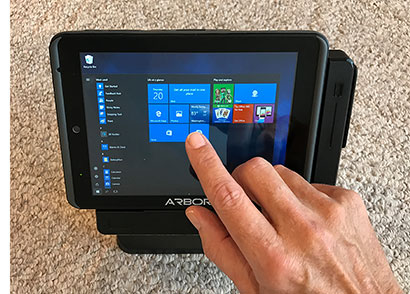 First, the 1024 x 768 pixel XGA format has been an industry standard for dedicated vertical market and industrial software in what seems like forever. Screen layouts are optimized for XGA and work best with XGA. Second, while many of today's leading smartphones have insanely high screen resolutions (think 4k TV video resolution on a tiny handheld), 160 ppi is actually quite good. Consider that even today, most of the leading fully-rugged laptops use XGA on their much larger 13.3-inch display and you get an idea how sharp and crisp 160 ppi looks on a small 8-inch screen.
First, the 1024 x 768 pixel XGA format has been an industry standard for dedicated vertical market and industrial software in what seems like forever. Screen layouts are optimized for XGA and work best with XGA. Second, while many of today's leading smartphones have insanely high screen resolutions (think 4k TV video resolution on a tiny handheld), 160 ppi is actually quite good. Consider that even today, most of the leading fully-rugged laptops use XGA on their much larger 13.3-inch display and you get an idea how sharp and crisp 160 ppi looks on a small 8-inch screen.
Display sharpness alone, of course, doesn't tell the whole picture. The display must also be bright enough for whatever working environment the device is intended for. Since the Gladius G0830 is intended to be used in retail, warehousing, and assorted point-of-sale applications, display is configured for those deployments rather than outdoor use. The spec sheet does not include nits rating. We'd estimate around 330 nits.
The spec sheet also doesn't list the display's viewing angles. Viewing angles, especially, are crucially important on tablets. Hunting for the angle that offers best viewing is unacceptable, as are displays that vary in contrast or brightness depending on the viewing angle. The Gladius G0830 screen as no such issues. Its IPS screen offers a near-perfect viewing angle without any degradations when viewing it from different angles.
Now what about the digitizer? For a very long time, tablets used either resistive touch that worked with a finger or a passive stylus, or they had an active digitizer with a special pen, usually of the Wacom variety, and sometimes they used both together. That all changed when first the iPhone and then the iPad popularized capacitive multi-touch with its effortless panning and pinching and zooming.
ARBOR chose 10-point capacitive multi-touch for the Gladius G0830, which makes sense as most applications will primarily require quick finger tapping.
Dock and data collection
We haven't said much about the Gladius G0830 dock. While most docks are optional accessories that some users need and others do not, the G0830's dock is really an integral part of the system. Yes, the tablet can be used without the dock and away from the dock, but the placement of important I/O on the dock rather than the tablet, and the small 15 watt-hour battery indicate that the G0830 and its dock work together.
So what does the dock provide, other than propping up the tablet? That'd be a standard HDMI port, a RJ-45 LAN jack for wired network connection, and three standard USB 2.0 ports. The cradle/dock also includes mag stripe reading, chipset card reading and NFC/RFID reading.
The tablet itself includes the 1D/2D barcode reader and a separate NFC/RFID reader. Add to that front (2 megapixel) and rear (8 megapixel) cameras, and you have a remarkably complete data collection system (which can additionally be augmented with a thermal printer).
Now add to that the optional pistol grip and things get even better. For deployments that require extensive scanning, having the tablet mounted on a pistol grip with scanner trigger works much better and allows optimized one-handed operation. In addition, to providing a much larger display than any pistol-grip handheld and adding another 18 watt-hour of battery power. That brings the total of the tablet and pistol grip to 33 watt-hour, plenty enough for extended operation.
Summary: ARBOR Gladius G0830
ARBOR officially lists their Gladius G0830 as a restaurant POS system, although one can easily envision uses in various other mobile and stationary point-of-sale systems, as well as warehousing, asset management and the like. It's also easy to view the device as part of various emerging IoT applications where it could serve both in data capture as well as monitoring and decision making functions.
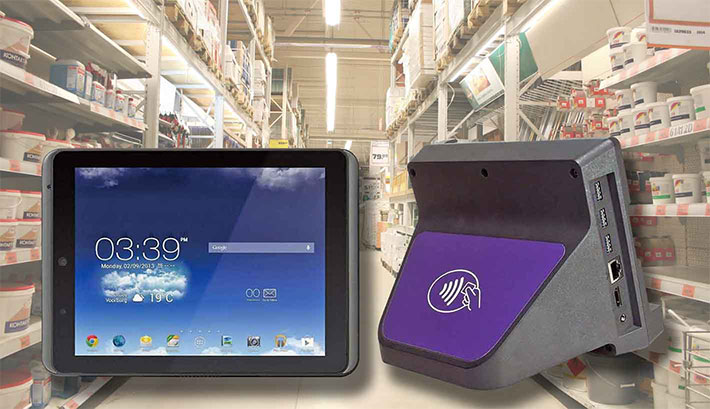
While the tablet can be used by itself, both with or without the optional pistol grip that more than doubles battery capacity, in most POS deployments, the Gladius G0830 will be used in conjunction with its dock. The dock provides MSR, chipcard, and smart card reading, as well as additional wired connectivity.
The tablet itself measures just 8.21 x 5.93 x 1.06 inches inches — barely more than an iPad mini — and weighing a mere pound and a quarter. Its 8-inch IPS capacitive touch screen offers 1024 x 768 pixel XGA resolution, making for a crisp, sharp picture and offering enough space to run Windows 10 comfortably.
Powered by a 1.44GHz quad-core Intel "Cherry Trail" processor, the Gladius provides enough performance for its intended applications, and it does so without the need of a fan. Its 64GB of onboard eMMC storage can be expanded via microSD card, and there are audio and microUSB ports.
From a durability standpoint, the IP54-sealed Gladius G0830 is a solid, well protected, and should easily be able to withstand hazards of the job. Ports are well-sealed with tight-fitting rubber plugs.
With the Gladius G0830, ARBOR Technology offers a compact, innovative, and very flexible mobile POS and data collection system suitable for a very wide range of applications. Especially intriguing is that the system is available with either Microsoft Windows 10 or Android 5.x, thus widening its appeal and allowing for inclusion into a wide variety of infrastructures.
-- Conrad H. Blickenstorfer, October 2016
ARBOR Technology Gladius G0830 Specs:
| Status |
Added 10/2016, updated 12/2017
|
| Type |
mPOS tablet
|
| Processor |
1.44GHz (1.92GHz burst frequency) quad-core Intel "Cherry Trail" x5-Z8350
|
| Graphics |
Intel HD Graphics 400 (12 EUs)
|
| CPU Scenario Design Power |
2 watts |
| OS |
Microsoft Windows 10 or Android 5.x |
| Memory |
2GB DDR3L
|
| Display |
8.0" XGA (1024 x 768 pixel) TFT |
| Digitizer |
10-point projected capacitive multi-touch |
| Keyboard |
Onscreen keyboard |
| Navigation |
Stylus, touch |
| Storage |
64GB eMMC
|
| Expansion slots |
1 x microSD card |
| Housing |
ABS plastic over magnesium alloy chassis/housing, rubber bumpers |
| Size |
Tablet PC: 208.5 x 150.6 x 27 mm (8.21" x 5.93" x 1.06")
Cradle & docking: 216 x 264 x 186 mm (8.50" x 10.39" x 7.32")
|
| Weight |
Tablet: 520g (1.15lb) (with battery)
Cradle & docking: 2.54kg (5.60lb)
|
| Operating temperature |
-4° to 113°F (-20° to 45°C)
|
| Temperature/humidity |
Est.: 10-95% non-condensing |
| Ingress protection |
IP54 |
| Altitude |
NA
|
| Drop/shock (with SSD) |
MIL-STD 810G, 506.6 VI: 4-foot drop, over concrete, onto each edge, face and corner (26 drops total) |
| Shock (with SSD) |
NA
|
| Salt Fog |
NA |
| Vibration |
NA |
| Power |
3.8 Volt 4,000mAH 15.2 watt-hour rechargeable Li-Polymer
|
| Cameras |
Rear: 8-megapixel AF, front: 2-megapixel |
| Sensors |
Gyroscope, eCompass, light sensor
|
| Interface |
Tablet itself: 1 x micro USB 2.0 w/ OTG support, 1 x chipset card reader slot
Cradle: 3 x USB 2.0, 1 x HDMI, 1 x RJ45 LAN
|
| Wireless options |
802.11a/b/g/n/ac WiFi, Bluetooth V4.1 BLE (Class 2), RFID/NFC, Zebra SE4710 1D/2D barcode scanner, MSR; u-blox NEO-M8N GPS
|
| Price |
Inquire |
| Contact |
ARBOR Technology Corp |
| Product page |
ARBOR Gladius G0830 product page |
| Data sheet |
 ARBOR Gladius G0830 data sheet ARBOR Gladius G0830 data sheet |
| Contact |
ARBOR Technology Corp.
10F., No.700, Zhongzheng Rd.
Zhonghe Dist., New Taipei City 235
Taiwan, R.O.C.
Tel: 886 2 8226 9396
Fax: 886 2 8226 9398 |
(copyright 2016 RuggedPCReview.com)
|



